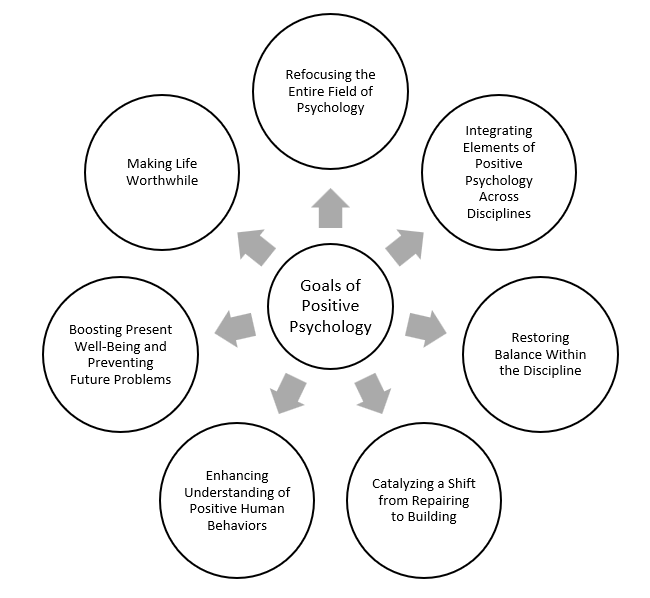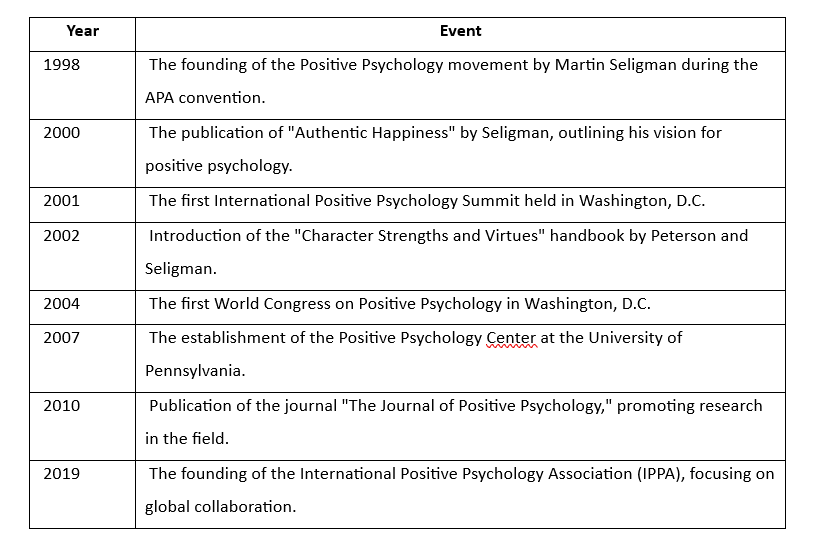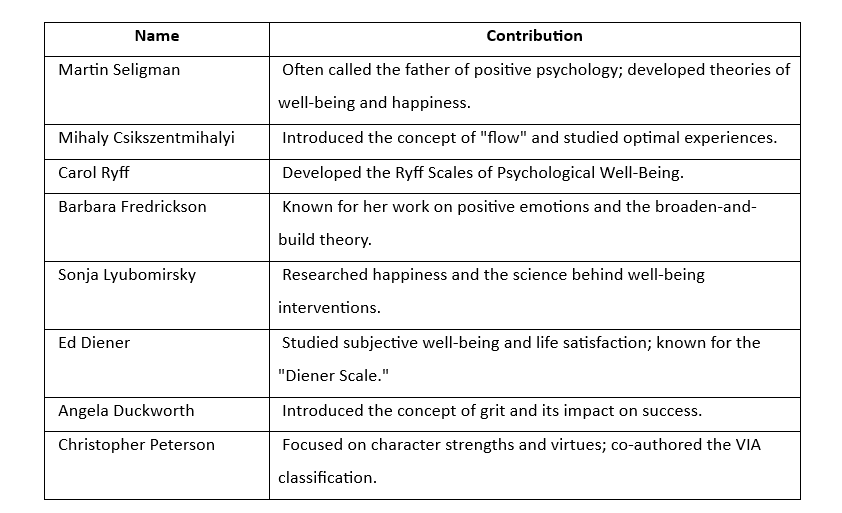Introduction
Positive psychology is a burgeoning field within psychology that focuses on the study of human strengths, virtues, and optimal functioning. Founded by pioneers like Martin Seligman and Mihaly Csikszentmihalyi, positive psychology seeks to shift the focus of psychological research from merely addressing mental illness to understanding what makes life fulfilling and meaningful.
This discipline encompasses a range of topics, including happiness, resilience, gratitude, and the conditions that foster well-being. By investigating the factors that contribute to a flourishing life, positive psychology aims to create a more balanced understanding of human experience, integrating both the challenges of mental health and the potential for personal growth.
Through empirical research and practical interventions, positive psychology offers valuable insights and tools that empower individuals to enhance their well-being and lead more fulfilling lives.
Definitions
Positive psychology, as a distinct subfield within psychology, emphasizes the study of what contributes to human flourishing and optimal functioning. This perspective is rooted in a commitment to understanding not only the alleviation of mental distress but also the enhancement of well-being and the cultivation of human strengths. Several influential scholars have contributed to the conceptualization of positive psychology:
Martin Seligman and Mihaly Csikszentmihalyi (2000) define positive psychology as “the scientific study of positive human functioning and flourishing on multiple levels,” which encompasses biological, personal, relational, institutional, cultural, and global dimensions of life. This definition underscores the multifaceted nature of well-being, suggesting that it extends beyond individual experience to encompass broader societal contexts.
Similarly, Sheldon and King (2001) describe positive psychology as “nothing more than the scientific study of ordinary human strengths and virtues.” This definition highlights the importance of examining the qualities that enable individuals to thrive, rather than focusing solely on psychopathology.
Gable and Haidt (2005) articulate positive psychology as “the study of the conditions and processes that contribute to the flourishing or optimal functioning of people, groups, and institutions.” This perspective emphasizes the relational aspects of well-being, recognizing that individual flourishing is intertwined with social dynamics and institutional support.
Peterson (2008) encapsulates the essence of positive psychology by stating, “Positive psychology is the scientific study of what makes life most worth living.” This definition reinforces the notion that positive psychology is not merely a reaction to negative experiences but an exploration of the factors that enhance life satisfaction.
The American Psychological Association (APA) defines positive psychology as a field that focuses on psychological states (e.g., contentment, joy), individual traits or character strengths (e.g., intimacy, integrity, altruism, wisdom), and social institutions that enhance subjective well-being. This comprehensive definition positions positive psychology as a vital area of inquiry within the broader psychological landscape, aiming to foster a more holistic understanding of human experience.
10 Important Definitions
- Martin Seligman & Mihaly Csikszentmihalyi (2000), The scientific study of positive human functioning and flourishing on multiple levels, including biological, personal, relational, institutional, cultural, and global dimensions of life.
- Sheldon and King (2001), Nothing more than the scientific study of ordinary human strengths and virtues.
- Gable and Haidt (2005): The study of the conditions and processes that contribute to the flourishing or optimal functioning of people, groups, and institutions.
- R. Snyder (2002), The scientific study of hope and its role in the flourishing of individuals and communities.
- Peterson (2008), The scientific study of what makes life most worth living.
- American Psychological Association (APA), A field of psychological theory and research that focuses on psychological states (e.g., contentment, joy), individual traits or character strengths (e.g., intimacy, integrity, altruism, wisdom), and social institutions that enhance subjective well-being.
- Seligman (2003), A science that aims to understand and promote well-being, happiness, and positive functioning in individuals and communities.
- Tal Ben-Shahar (2007), The study of happiness and what it means to live a fulfilling life.
- Keyes (2003), The study of well-being and human flourishing, encompassing both the absence of mental illness and the presence of positive mental health.
- Martin Seligman (2011), A field that focuses on building the best in people and institutions, rather than just repairing the worst.
Seligman (2003) proposes three pillars of positive psychology–
- Positive Subjective Experiences- This includes emotions such as joy, happiness, contentment, optimism, and hope. These experiences are integral to individual well-being and serve as indicators of a life well-lived.
- Positive Individual Characteristics- This pillar encompasses personal strengths and virtues that promote mental health. Traits such as resilience, empathy, and courage play a crucial role in facilitating positive experiences and enhancing life satisfaction.
- Positive Social Institutions- These are communities and systems that contribute to individual health and happiness. Positive social structures, such as supportive relationships and inclusive organizations, are essential for fostering well-being.

Important Assumptions
Assumptions
Positive psychology is built upon several foundational assumptions that distinguish it from traditional psychological paradigms. One of the core assumptions is that the field of psychology has become unbalanced, predominantly focusing on disorders, distress, and pathology (Simonton & Baumeister, 2005). This narrow emphasis on mental illness often overshadows the equally important study of human strengths and positive experiences. By centring the discourse on what is wrong with individuals, traditional psychology risks neglecting the rich tapestry of human capability, resilience, and potential for growth.
This imbalance calls for a shift in focus. Human goodness and excellence are as authentic and significant as psychological disorders; therefore, they deserve equal attention from mental health practitioners (Maddux, 2002). This assertion is vital for creating a more holistic understanding of mental health. For instance, while traditional models may address issues such as depression or anxiety, positive psychology seeks to explore qualities like optimism, gratitude, and resilience. By acknowledging the validity of positive traits, psychologists can foster a more comprehensive approach to mental health that promotes not only the alleviation of suffering but also the enhancement of well-being.
Another key assumption of positive psychology is the belief that human beings possess the potential for goodness and are inherently motivated to pursue a fulfilling life (Linley & Joseph, 2006). This intrinsic motivation underpins many interventions and practices within the field. Rather than viewing individuals as passive recipients of treatment, positive psychology encourages the understanding that people have the agency to cultivate their well-being actively. This perspective empowers individuals to engage in practices that enhance their strengths and promote positive experiences, such as mindfulness, gratitude, and community engagement.
Positive psychology also challenges the deterministic view often associated with traditional psychology, which can lead to a fatalistic outlook on human behavior. Instead, it emphasizes the capacity for personal growth and transformation. This assumption aligns with the idea that individuals can develop resilience and coping strategies, enabling them to navigate life’s challenges more effectively. By focusing on the potential for positive change, psychologists can inspire clients to envision and work towards a more fulfilling life.
Furthermore, positive psychology posits that the study of well-being should not be limited to individual experiences but should also encompass social and environmental factors that contribute to flourishing. This broader perspective acknowledges the interconnectedness of individuals and their communities, highlighting the role of supportive relationships, social institutions, and cultural contexts in enhancing well-being. By examining these dynamics, positive psychology seeks to create a more comprehensive understanding of what it means to live a fulfilling life.
The assumptions of positive psychology advocate for a balanced approach to psychological inquiry. By acknowledging the significance of human strengths and the potential for positive change, positive psychology seeks to enrich the field of psychology as a whole. This framework not only encourages the exploration of well-being but also empowers individuals to take an active role in their mental health journey, fostering resilience and growth in the face of life’s challenges. Through this lens, psychology can evolve to embrace a more holistic understanding of human experience, one that honours both the struggles and the strengths of individuals.
Goals
Positive psychology, as articulated by Martin Seligman, encompasses several transformative goals aimed at reshaping the understanding and practice of psychology. These goals not only emphasize the importance of positive experiences and traits but also seek to foster a more balanced and holistic approach to mental health.

Goals
- Refocusing the Entire Field of Psychology
One of Seligman’s primary goals is to shift the emphasis of psychology from a predominantly negative focus to a more balanced approach. Traditional psychology has often concentrated on diagnosing and treating mental illnesses, thereby overshadowing the study of positive experiences and traits. For example, research on happiness, resilience, and character strengths was relatively limited before the emergence of positive psychology. Seligman advocates for the inclusion of these positive elements, encouraging psychologists to explore what makes life worth living. Studies such as those conducted by Diener (2000), which examine the factors contributing to subjective well-being, illustrate the potential for integrating positive experiences into psychological research and practice.
- Integrating Elements of Positive Psychology Across Disciplines
Seligman aims to create a more unified understanding of human experience by incorporating aspects of positive psychology into various areas of psychological research, including physiological and clinical psychology. For instance, the study of how positive emotions can influence physical health has gained traction, with research indicating that positive affect can boost the immune system and reduce the risk of chronic diseases (Cohen et al., 2003). By fostering interdisciplinary collaboration, positive psychology encourages researchers to explore the interplay between positive traits and health outcomes, leading to a more comprehensive understanding of well-being.
- Restoring Balance Within the Discipline
There is a growing recognition of the need to counteract the traditional emphasis on pathology and suffering in psychology (Sheldon & King, 2001). Seligman argues for a more holistic view of mental health that incorporates both the understanding of disorders and the cultivation of strengths. For example, therapeutic approaches such as Acceptance and Commitment Therapy (ACT) focus not only on addressing psychological distress but also on promoting values-based living and psychological flexibility. This balanced perspective allows practitioners to support clients in not only alleviating their suffering but also enhancing their overall well-being.
- Catalyzing a Shift from Repairing to Building
Seligman emphasizes the importance of not only addressing negative aspects of life but also actively cultivating positive qualities and experiences. This shift from a deficit-oriented model to one that promotes growth is evident in interventions like Positive Psychology Coaching, which focuses on identifying and enhancing personal strengths. For instance, Gallup’s StrengthsFinder assessment helps individuals recognize their innate talents, empowering them to leverage these strengths in various aspects of their lives, from career to relationships.
- Enhancing Understanding of Positive Human Behaviors
By focusing on positive behaviors, researchers can develop a nuanced understanding of what contributes to well-being. For example, studies by Fredrickson (2001) on the broaden-and-build theory of positive emotions illustrate how experiencing positive emotions can expand one’s cognitive resources and foster resilience. This understanding informs both personal practices, such as gratitude journaling, and professional interventions, like strengths-based therapy, which encourage individuals to cultivate positive behaviors that enhance their overall quality of life.
- Boosting Present Well-Being and Preventing Future Problems
Positive psychology aims to enhance current well-being while equipping individuals with tools to prevent future psychological issues. Interventions like mindfulness-based stress reduction (MBSR) not only promote immediate well-being through mindfulness practices but also help individuals build resilience against future stressors. Research has shown that mindfulness can reduce anxiety and depression, contributing to long-term psychological health (Kabat-Zinn, 2003). This proactive approach underscores the importance of equipping individuals with strategies to enhance their mental well-being.
- Making Life Worthwhile
Ultimately, the overarching goal of positive psychology is to enhance the quality of life and promote flourishing in individuals and communities. This includes fostering a sense of purpose, engagement, and fulfillment. Seligman’s PERMA model—comprising Positive Emotion, Engagement, Relationships, Meaning, and Accomplishment—provides a framework for individuals to evaluate and enhance their well-being. Research supports the idea that individuals who cultivate these elements experience higher levels of life satisfaction and overall happiness (Seligman, 2011).
The goals of positive psychology represent a paradigm shift in the field of psychology, encouraging a balanced approach that values both the understanding of suffering and the cultivation of human strengths. By focusing on enhancing well-being, integrating interdisciplinary perspectives, and fostering proactive strategies, positive psychology aims to enrich the quality of life for individuals and communities alike.
Conclusion
Positive psychology represents a transformative approach to understanding human behavior and well-being. By emphasizing the importance of positive experiences, strengths, and the pursuit of meaning, this field challenges traditional psychological paradigms that often focus solely on pathology and dysfunction.
The goals —ranging from fostering a balanced understanding of mental health to equipping individuals with the tools for personal growth—underscore its relevance in today’s world. As we continue to explore and apply the principles of positive psychology, we pave the way for not only individual flourishing but also for healthier communities, ultimately making life more worthwhile for everyone.

Key Events

Key Figures
References
Baumgardner, S. R., & Crothers, M. K. (2009). Positive Psychology: Pearson Education.
Gable, S. L., & Haidt, J. (2005). What (and Why) is Positive Psychology? Positive Psychology in Practice, 3-12.
Keyes, C. L. M. (2003). Complete Mental Health: An Agenda for the 21st Century. The Science of Well-Being, 293-321.
Linley, P. A., & Joseph, S. (2006). Positive Psychology in Practice: Applications and Interventions. Psychology, Health & Medicine, 11(2), 151-159.
Maddux, J. E. (2002). The Importance of the Human Condition: Integrating Positive Psychology with Clinical Psychology. The Psychologist, 15(7), 372-374.
Peterson, C. (2008). Positive Psychology: Scientific and Practical Approaches to Happiness. American Psychological Association.
Seligman, M. E. P. (2003). Positive Psychology: An Introduction. American Psychologist, 55(1), 5-14.
Sheldon, K. M., & King, L. (2001). Why Positive Psychology is Necessary. American Psychologist, 56(1), 216-217.
Simonton, D. K., & Baumeister, R. F. (2005). Psychology: A Science of Human Strengths. Perspectives on Psychological Science, 1(2), 185-189.
Subscribe to Careershodh
Get the latest updates and insights.
Join 16,620 other subscribers!
Niwlikar, B. A. (2022, May 4). Positive Psychology- Master 10 Definitions, Key Assumptions & 7 Goals of Positive Psychology. Careershodh. https://www.careershodh.com/definitions-of-positive-psychology/

This blog post on Positive Psychology is incredibly insightful! I love how you’ve broken down the definitions and key assumptions so clearly. The focus on practical goals really highlights how we can apply these concepts in our daily lives. Looking forward to implementing some of these strategies! Thank you for sharing!